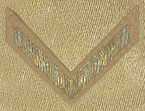Wound Chevron

A Wound Chevron was a badge of the United States Army which was authorized for wear on an Army uniform between the years of 1918 and 1932. The Wound Chevron was displayed on the lower right cuff of a military uniform, and denoted wounds which were received in combat against an enemy force. The Wound Chevron was a replacement insignia for the short lived Army Wound Ribbon.
In 1932, with the creation of the Purple Heart, Wound Chevrons were no longer awarded to Army personnel. A directive of the United States War Department permitted soldiers to exchange wound chevrons for the new Purple Heart medal. This was not required, however, and some Army personnel elected to retain wound chevrons for wear on the military uniform instead of the Purple Heart. For those who were subsequently wounded in the Second World War, both the original wound chevrons and the Purple Heart medal were worn simultaneously. It is historically agreed that Army regulations did not permit wearing both the Purple Heart and the Wound Chevron at the same time; however, photographic evidence indicates that this was often done by veterans of both the First World War and Second World War.
In the modern military, the Wound Chevron is considered obsolete. The decoration is very similar to the Overseas Chevron, which in World War I was worn on the left sleeve.